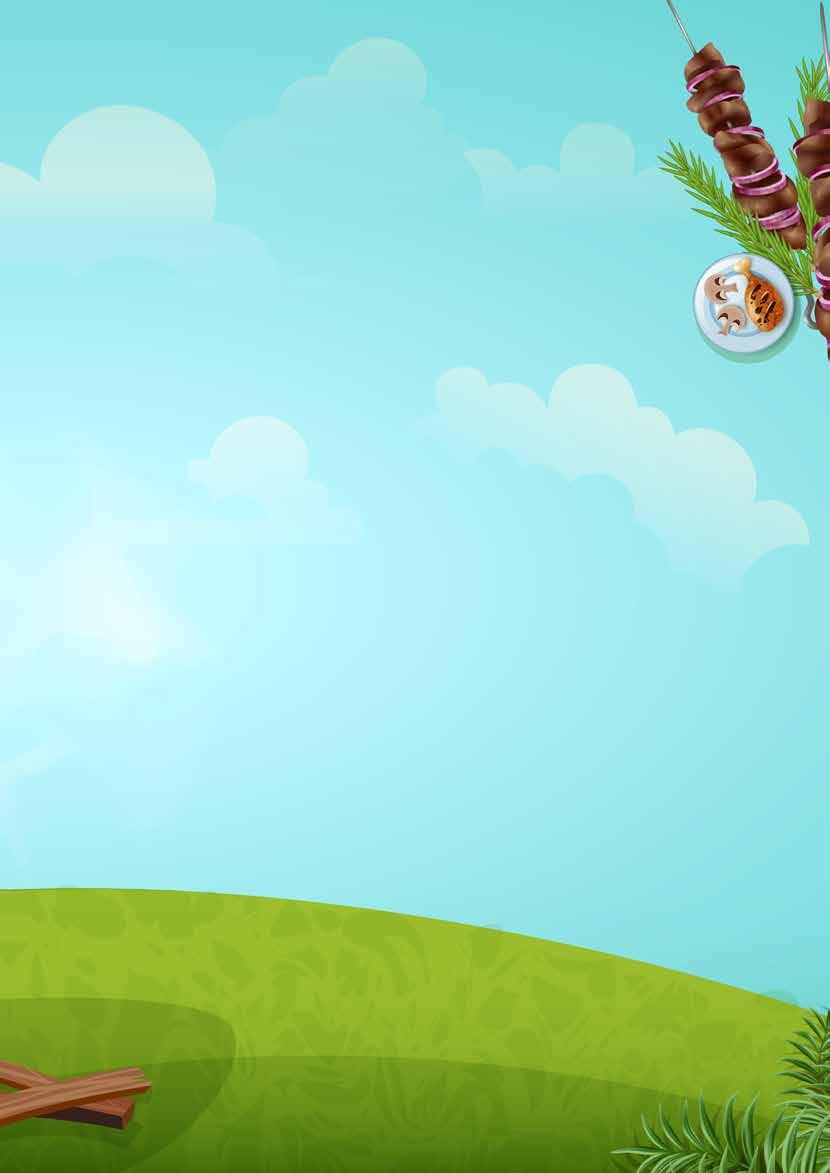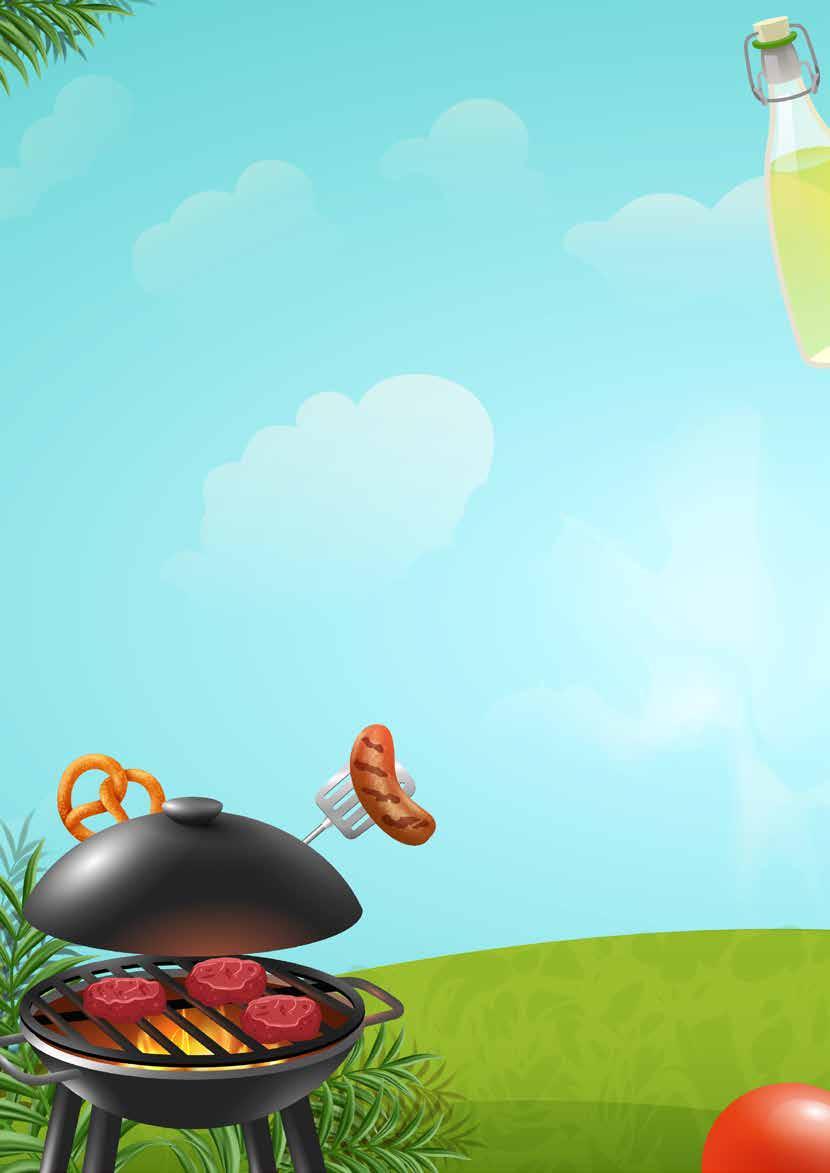
9 minute read
Become a BBQ Pro
Summer is a great time to enjoy a BBQ with family and friends, yet warm weather and outdoor cooking can be the perfect conditions for bacteria to grow. Food poisoning is more than just a passing ‘tummy bug’ and can be very serious. It can be caused by various bacteria including:
• Campylobacter • Salmonella • Listeria • Some types of E. coli
Advertisement
Most cases of food poisoning can be avoided by following good food hygiene practices, such as washing your hands, cooking meat properly, and avoiding cross-contamination.
So, here's some tips for looking after your food and guests, during, and after your BBQ
Preparing for your BBQ
Help minimise the risk of germs spreading by:
• Washing hands thoroughly with soap and hot water before and after cooking and eating - this is particularly important if you've been handling raw meat or firelighter
Wash your hands and clean your utensils and surfaces
• Keeping utensils and serving dishes clean when preparing food - ensure you don't mix utensils used to prepare raw and ready-to-eat dishes. For example, using different chopping boards for raw meat and vegetables or fruit, or washing the same board between different uses • Never washing raw chicken or any other meat - washing raw meat risks splashing germs onto your hands, utensils and worktops
Defrosting meat
Frozen meat tends not to cook through thoroughly on a BBQ. Plan ahead and defrost food overnight in the fridge, making sure juices don’t leak onto other food. Use a dish with a lip or rim and place in the bottom of the fridge. If this isn’t possible or it hasn’t defrosted fully in time, use a microwave on the defrost setting directly before cooking. Once food has been defrosted, eat it within 24 hours.
Check the use-by dates
The use-by date is on food packaging for a reason. Eating food that’s past its use-by date can make you ill. Best before dates (sometimes shown as BBE) are about quality. The food will be safe to eat after the best before date but may not be at its best. If your barbecue has been sat out in the garden for a while, inspect and clean it. Even if you’ve recently used your equipment it’s good practice to clean and dry the grill beforehand. If you’re using charcoal (rather than a gas-fired BBQ) make sure the coals are hot enough before you start cooking. They should be glowing red with a grey, powdery surface. Wait for the flames to die down before placing food on the grill or the flames will burn the outside of the food but the centre of the food will remain raw or undercooked
Clean the grill Cooking on Charcoal
Cooking and avoiding cross-contamination during a BBQ
Prevent cross-contamination by: Cross-contamination is most likely to happen when raw food touches or drips onto ready-to-eat food, utensils, or surfaces.
• Storing raw meat separately from ready-to-eat foods • Using different utensils, plates and chopping boards for raw and cooked food • Washing your hands after touching raw meat and before you handle ready-to-eat food
Marinades are a popular way to flavour food at a BBQ. Do not reuse a sauce or marinade, which has already been put on raw meat, with cooked or ready to eat food. Be careful to avoid dripping meat and fish juices from raw food to ready to eat food. Avoid cross-contamination
Cook meat in the oven first
Consider cooking chicken and pork in the oven first, then giving it a final finish on your barbecue. Your friends and family will still experience that chargrilled barbecue taste, and you will know that you have cooked the meat all the way through. If you’re expecting lots of people, this can also speed serving time up. Cooking meat in the oven first can also help you avoid other issues, such as with the BBQ coals not being hot enough or having too much food on the grill.

Avoid pink burgers and undercooked sausages first
At home, you should serve burgers well done. This means not serving rare or pink burgers. This is because when meat is minced to produce burgers, any harmful bacteria from the surface of the raw meat spread throughout the burger. Unless the burger is cooked right through, these bacteria can remain alive on the inside. This also applies to all food made from minced meat, such as sausages and kebabs. The quality of the meat you buy doesn't affect the potential risk from harmful bacteria. Rare burgers can be served by some restaurants due to extra controls they’re able to put in place. These are difficult to replicate at home.
Cook BBQ meat thoroughly
It’s important to cook food at the right temperature and for the correct length of time. This kills any harmful bacteria. Different types of meat will have different cooking requirements: • Red meat such as steaks can be served pink, rare or bloody and pose no risk to health
• Other meats, like chicken and pork, as well as minced meat products such as burgers, kebabs and sausages, should not be served pink or rare Turn your meat regularly on the grill and move it around to make sure it’s evenly cooked on all sides. Try and keep raw meat away from cooked meat on the grill. Remember that charred on the outside doesn't always mean cooked on the inside. Before serving meat that you’ve cooked on the barbecue, always check that: • The meat is steaming hot throughout • There is no pink meat visible when you cut into the thickest part • Meat juices run clear
Cooking rare burgers
Steaks and red meat are not the same as burgers or white meat like chicken and pork and can be served rare, pink, or bloody. Steaks and red meat don’t pose the same risks as minced meat, chicken or pork.
You should use different plates for raw meat, cooked meat, and ready to eat food such as salads and quiches. Use different utensils for different foods.
Keep chilled food out of the fridge for the shortest time possible during preparation. This also applies to any desserts you have planned. It’s best to store chilled food in the fridge or cool bag until the main course is finished.
You may also want to keep any perishable foods, and food usually kept in the fridge, chilled and out of the sun until serving.
Serving food safely at a BBQ
Managing leftovers and reducing food waste
You may have food left from your barbecue that can be eaten another day. If so, cover and cool cooked foods quickly at room temperature. Place them in a fridge or cool bag within one to two hours, especially on hot days. Take the leftovers indoors as soon as you can. This keeps the food out of the sun and away from insects and animals. You should look to consume the leftovers from your barbecue within 48 hours. If you’re reheating anything, only reheat it once and make sure it’s piping hot before serving. To prevent unnecessary waste, plan beforehand: Over 70% of food waste in the UK comes from homes. Barbecues are big contributors to food waste so here’s some tips from ‘Love Food – Hate Waste’ to make sure you’re not wasting food this barbecue season.
Whatever tasty treats you’ve got in your shopping basket, try storing as much as possible in your freezer where it stays safe and ready for when you need it.
Our top freezing tips:
1. Have one or two packs of each food product chilling in the fridge and the rest in the freezer. This way, you won’t cook more than you need and anything you don’t get round to using will stay safely frozen for another time. 2. When storing in the fridge: check it’s at less than 5°C, cover raw food, including meat, and keep it separate from readyto-eat food. 3. Store covered raw meat, poultry, fish and shellfish on the bottom shelf of the fridge. You might not believe us, but every year 100,000 tonnes of pork are wasted in UK homes. The main reason is because we simply don’t use it in time! Popping some of your sausages straight in the freezer avoids this problem, giving you plenty of time to enjoy them.
Remember – you can freeze most of your BBQ foods any time before the ‘use by’ date, not bad eh?!
Defrost like a boss
Office job by day, BBQ pro by night
Your chicken wings, sausages, steaks or burgers need to be defrosted thoroughly before cooking. You can either: • Defrost in the fridge – at the bottom, well wrapped, the day before; or • Defrost in the microwave immediately before cooking using the ‘defrost’ setting. The microwave option is perfect for on-the-day. If you’ve got through what was in your fridge and someone’s after a cheeky second helping, you can defrost quickly in the microwave! You can defrost exactly what you need and avoid having too much that will end up going to waste. This is also a great option for finishing off the defrosting if your food didn’t quite defrost enough in the fridge. Need some extra help with defrosting your BBQ food? The FSA has plenty of guidance to help you prevent any nasty surprises as well as some top tips on cooking meat, including burgers, safely!
If you’re in charge of the barbie, simply act the waiter and take orders!
Ask your group what they want before popping everything on the BBQ and go in ‘rounds’. Better to cook up a round of burgers or sausages at a time rather than everything all at once – if people change their minds or get full, you’re not left with an unfinished feast. Keep your defrosted, uncooked meat nice and chilled (in the fridge) so it’s as fresh as possible when it goes on the BBQ. Anything that’s still uncooked at the end of the day can be frozen for later. Fresh goodies can be frozen before their ‘use by’ date ready for another day. If the food has already been frozen and defrosted, you’ll need to use it within 24 hours. Or you can cook it into a meal – for example, make a toad in the hole with your remaining Cumberlands – and freeze that, so the possibilities are really endless! Need some then take a look at our wide range of delicious recipes?

BBQs are a perfect summer-time activity and with a little planning you can prevent them from ending with wasted food. And if you need more storage advice, check out our www.lovefoodhatewaste.com/article/foodstorage-a-z







